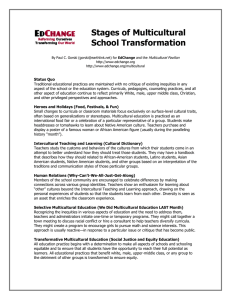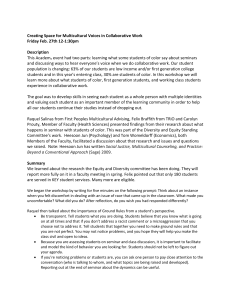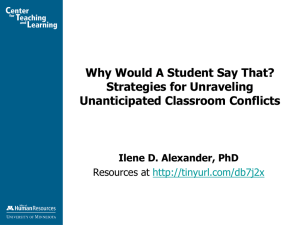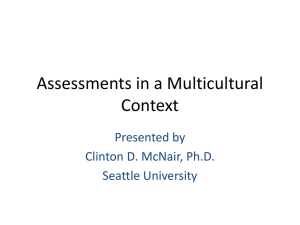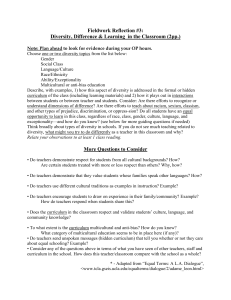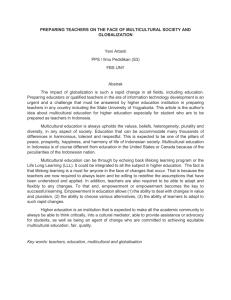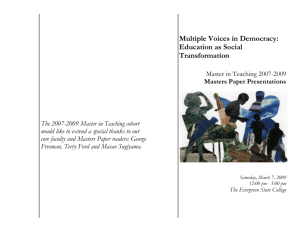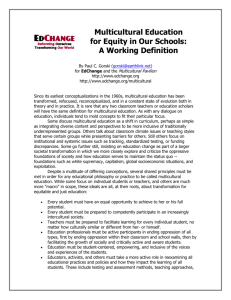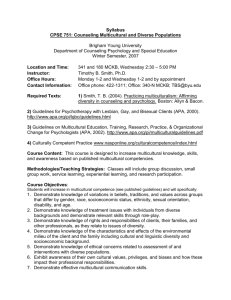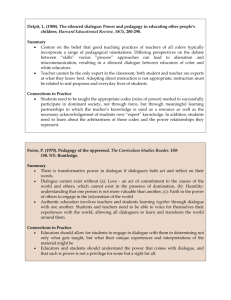Key Characteristics of a Multicultural Curriculum
advertisement
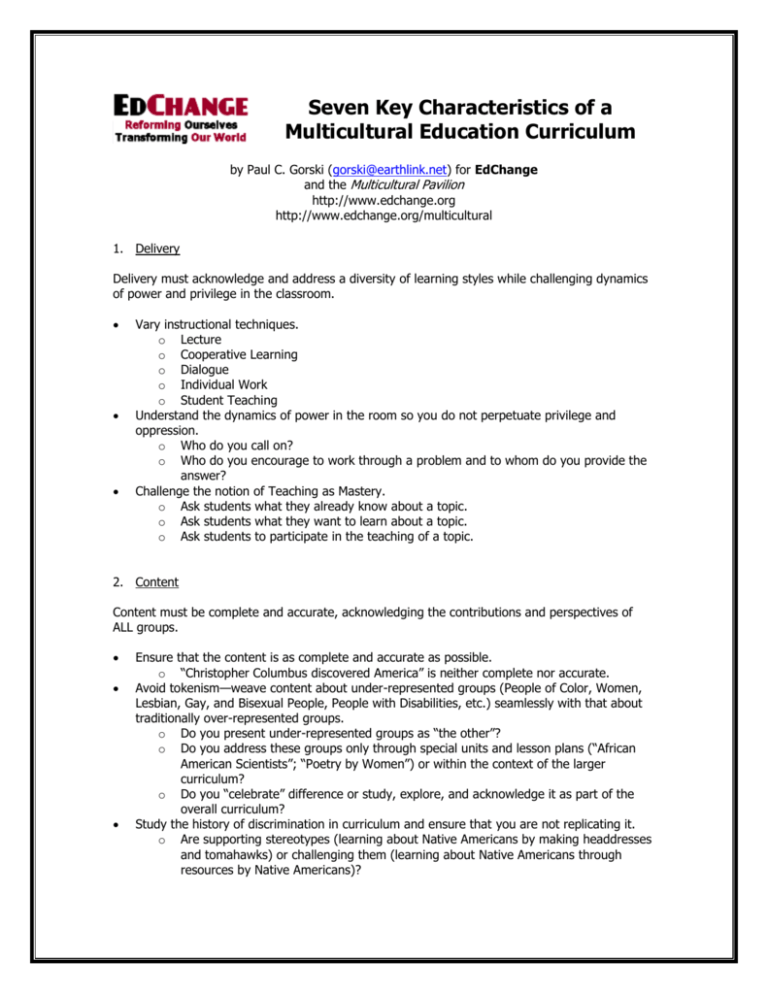
Seven Key Characteristics of a Multicultural Education Curriculum by Paul C. Gorski (gorski@earthlink.net) for EdChange and the Multicultural Pavilion http://www.edchange.org http://www.edchange.org/multicultural 1. Delivery Delivery must acknowledge and address a diversity of learning styles while challenging dynamics of power and privilege in the classroom. Vary instructional techniques. o Lecture o Cooperative Learning o Dialogue o Individual Work o Student Teaching Understand the dynamics of power in the room so you do not perpetuate privilege and oppression. o Who do you call on? o Who do you encourage to work through a problem and to whom do you provide the answer? Challenge the notion of Teaching as Mastery. o Ask students what they already know about a topic. o Ask students what they want to learn about a topic. o Ask students to participate in the teaching of a topic. 2. Content Content must be complete and accurate, acknowledging the contributions and perspectives of ALL groups. Ensure that the content is as complete and accurate as possible. o “Christopher Columbus discovered America” is neither complete nor accurate. Avoid tokenism—weave content about under-represented groups (People of Color, Women, Lesbian, Gay, and Bisexual People, People with Disabilities, etc.) seamlessly with that about traditionally over-represented groups. o Do you present under-represented groups as “the other”? o Do you address these groups only through special units and lesson plans (“African American Scientists”; “Poetry by Women”) or within the context of the larger curriculum? o Do you “celebrate” difference or study, explore, and acknowledge it as part of the overall curriculum? Study the history of discrimination in curriculum and ensure that you are not replicating it. o Are supporting stereotypes (learning about Native Americans by making headdresses and tomahawks) or challenging them (learning about Native Americans through resources by Native Americans)? Multicultural Education Curriculum o 2 Are you supporting or challenging the assumption that our society is inherently Eurocentric, male-centric, Christian-centric, heterosexual-centric, and upper-middleclass centric? 3. Teaching and Learning Materials Teaching and learning materials must be diverse and critically examined for bias. Vary instructional materials. o Texts o Newspapers o Videos/Movies o Games o Workbooks Examine all materials for bias and oppressive content. o Does your history book show stereotypical or inaccurate images of people from certain groups or eras (ex. railroad workers)? o Do your science materials use male-centric language? o Do your reading or literature materials have racist language or stereotypical images (ex. the Huck Finn debate)? o Does the language you use and the language your materials use assume heterosexuality, a 2-biological-parent household, American citizenship..? Diversify images and content in bulletin boards, posters, and other constantly-visible materials. o Do you ALWAYS diversify, or only during special months or celebrations? 4. Perspective Content must be presented from a variety of perspectives and angles in order to be accurate and complete. Present content from a variety of perspectives, not only that of majority groups. o How do we define “classic literature” or “great books” or “the classics” and from whose perspective? o From whose perspective do we tell history? When is “westward expansion” the same as “genocide”? When are champions of “liberty” the same as slave owners? Present content through a variety of lenses, not just those of a few heroic characters. o Slave narratives to teach about slavery (not Frederick Douglas). o Slave narratives to teach about colonial Virginia. o Native American texts to teach about westward expansion. 5. Critical Inclusivity Students must be engaged in the teaching and learning process—transcend the banking method and facilitate experiences in which students learn from each other’s experiences and perspectives. Bring the perspectives and experiences of the students themselves to the fore in the learning experience. Multicultural Education Curriculum 3 Encourage students to ask critical questions about all information they receive from you and curricular materials, and model this type of critical thinking for them. o Who wrote or edited that textbook? o Who created that Web site? o Whose voice am I hearing and whose voice am I not hearing? Make content and delivery relevant for the students—facilitate experiences in which they connect it with their everyday lives. Recognize your students as your most important multicultural resources. 6. Social and Civic Responsibility If we hope to prepare students to be active participants in an equitable democracy, we must educate them about social justice issues and model a sense of civic responsibility within the curriculum. Starting with the youngest students, incorporate discussions about difference and inequality into your lessons—this can be done across all subject areas. o How has misapplied science been used to justify racism and anti-Semitism? Look for ways in which recognized names in various disciplines used their work and stature to fight social injustices. (It can be particularly powerful to find people from majority groups who fought certain types of oppression.) o Mark Twain o Albert Einstein o Eleanor Roosevelt When an opportunity arises to address racism, sexism, homophobia, classism, or other forms of oppression, facilitate it. Have honest discussion with your students about the history of privilege and oppression in your subject area, school, education, and society at large. Connect teaching and learning to local community and larger global issues. Encourage students to think critically about the United States, capitalism, the two-party system, and other traditionally untouchable subjects of critique. 7. Assessment Curriculum must be constantly assessed for completeness, accuracy and bias. Work with a cohort of teachers to examine and critique each other’s curricular units, lesson plans, and entire frameworks. Request and openly accept feedback from your students. Return to this model from time to time to make sure you haven’t reverted to former practices.
